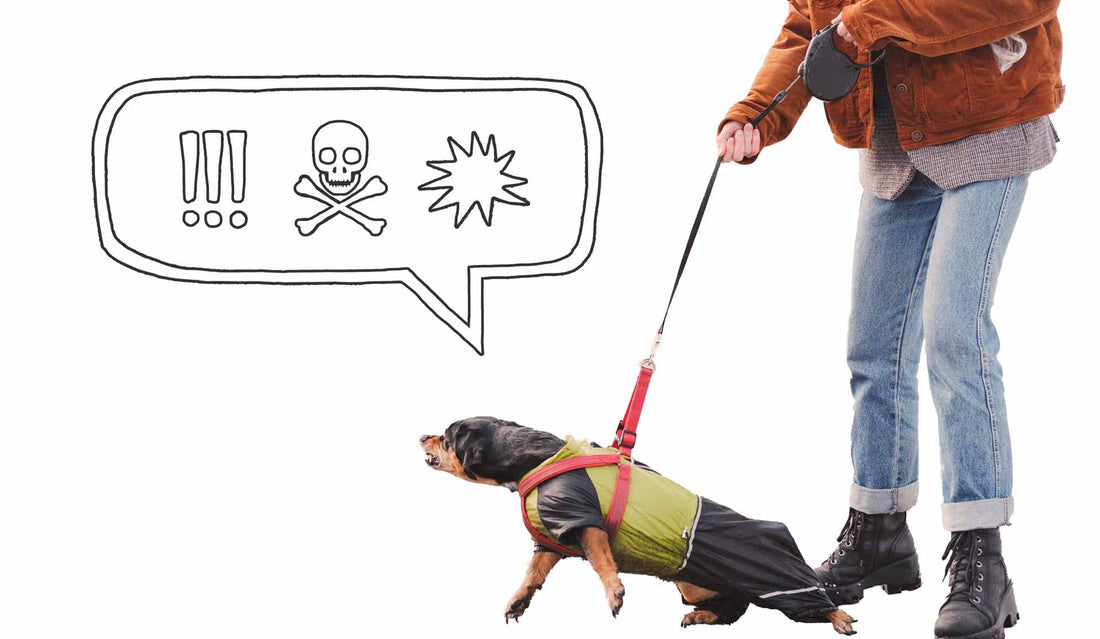
Reactive Dog Training: Tips & Tricks
If you or someone you know has adopted a reactive dog, it can be a frustrating experience. You might wonder how you can help or if the dog is even trainable at all. Often, owners of reactive dogs will keep them inside or away from other dogs, and the situation might seem helpless, which only exacerbates the problem. Luckily, reactive dogs are trainable with the correct methods and a bit of understanding mixed with patience.

What is a Reactive Dog?
You might be wondering, "what exactly is a reactive dog?" Simply put, reactive dogs are defined as dogs that overreact to certain stimuli or situations, such as other dogs or people. Understanding that dog reactivity stems from fear rather than aggression is crucial. There are many reasons a dog might be reactive, including:
- Breed: A number of breeds are unfairly mislabeled as prone to reactivity, but the truth is, most breeds can suffer. Even common “family dogs” such as terriers, Australian Shepherds, and Border Collies.
- Past Trauma: If your pup has a history of abuse or even one bad experience, it can result in reactive behavior.
- Lack of Socialization: Puppies should be socialized from a young age. While vets do recommend your puppy be dewormed and have one round of shots complete, it is safe for your puppy to begin puppy classes or other social activities as early as seven weeks. Nevertheless, it is never too old to socialize a dog with the proper techniques.
- Lack of Training: Perhaps the dog hasn't been trained correctly, enough, or at all. Sometimes dog owners do not know effective strategies to coach their pup or give up after losing hope. Resist the temptation! Your dog deserves to live their happiest, healthiest life.
Triggers

The first step in understanding and training a reactive dog is determining the pet's trigger or triggers. Common triggers include people in hats, bikes, children, leashes, strangers, and other animals. A dog might have one trigger or many.
Although it might seem natural to scold and reprimand a triggered dog, this will only cause further damage. To the dog, your reaction reaffirms the danger. Instead, staying calm and learning proper behavior and techniques will help your dog manage their own behavior.
Recognizing Body Language

Calm

In this state, your dog is exhibiting calm, friendly behavior, including:
- Relaxed body and ears
- Soft, blinking eyes
- Relaxed, wagging tail
- If on a leash, the leash is lax
Anxious Moment

When your dog encounters a trigger, it might first exhibit these signs:
- Panting
- Tucked tail
- Scratching
State of Arousal

If your dog becomes triggered, they may:
- Tense their body and posture
- Show the whites of their eyes
- Begin growling
- Stop responding to you
Aggression

By scolding, the reaction may worsen, resulting in:
- Barking
- Lunging
- Complete nonresponsiveness to owner
- Baring of teeth
Managing Reactive Dogs
While training a reactive dog is the end goal, it's process that can't be rushed. While your reactive dog is in training, managing the reactivity is key. Here are some tips:
- Avoid stressful situations when you sense your dog is anxious or showing signs of aggression. This can mean walking the dog across the street when you see another dog coming, putting an obstacle between the dog's viewpoint so they can’t see the trigger, or going home when the reactive dog shows signs of anxiety.
- Give the dog a long lead. While this may seem counterintuitive, a short lead makes a reactive dog feel trapped, increasing anxiety.
- If the dog shows signs of reactivity on walks, try walking in low-traffic areas or at times of day that are less busy.
- Long walks around the same location help a dog feel secure. As they walk, they sniff and familiarize themselves with the area. Coming back to the same area will help the reactive dog feel safe.
Reactive Dog Training
While managing reactivity is a good step, the goal is to eventually modify the behavior using reactive dog training. There are professional dog trainers who specialize in reactive dogs, but if you would like to undertake the task of reactive dog training yourself, there are some things to keep in mind.
First, to modify the dog's behavior, you must reassociate the meaning of the trigger to the dog. For example, if your dog is triggered by large dogs, you must reprogram your reactive dog to have a positive association with large dogs, but how? Luckily, there are some steps to take.
- Pick out a high-value treat your dog loves. This isn't an ordinary treat. It should be a special treat such as chicken, bacon bits, or cheese bits.
- Take the reactive dog to a park where they are within eyesight of triggers but far enough away to not react. Familiarizing the pup with their trigger makes it less novel and exciting.
- When your dog sees the trigger, you give them a treat. This conditions the dog to associate the trigger with the yummy treat instead of danger.
- Slowly, over time, allow the dog to go closer and closer to the trigger while offering a treat when they stay calm and don't react.
Common Mistakes with Reactive Dogs

While some dogs are always reactive to triggers, others struggle only while on leashes specifically. When you leash a reactive dog, they feel that they lose control. When the reactive dog feels the taut leash, they often feel the only way out is to attack, resulting in lunging or snarling. These are some other common mistakes pet parents make when training a reactive dog:
- Training will be ineffective unless your behavior and treat distribution are consistent. Remember, it all starts with you.
- Often, pet parents shorten the leash when they see a trigger. Tugging on the leash or keeping it too taut will only make a reactive dog feel more trapped. Creating a safe distance and using barriers are much more effective.
- Do not overload your dog. If your reactive dog is exposed to too many triggers in too short a period, they will likely feel overwhelmed and react. Less is more, especially in the beginning.
Reactive Dog Training Tips
Although reactive dog training is relatively straightforward, some tips and tricks have proven effective for dog owners.
Try Playing Games
Dogs that love to play fetch or frisbee are often distracted and uninterested in triggers. They also associate being around triggers positively, as it also means they will get to have fun playing.
Dogs Do Better with a Routine
Just like humans, having a set routine helps reduce uncertainty in a dog's daily life, reducing overall anxiety.
The Takeaway
The most crucial aspect of all training is patience. Do not expect your reactive dog's behavior to change overnight. Check in with your dog and keep training on a level they’re comfortable with. Managing reactivity is an effective practice while the reactive dog training is in progress.
Most of all, have fun. Dogs and humans alike enjoy fun and each other. Implement fun excursions and activities. If either of you gets frustrated, back off and try another time – together.






